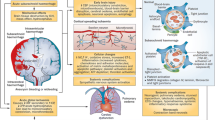Summary
112 patients operated on for an intracranial aneurysm were surveyed. The immediate (up to 3 days from surgery) and late (from 3 days onwards and up to 2 years) outcome was examined in relation to the level and duration of per-operative hypotension as well as technical difficulties.
The risk of both immediate and late post-operative neurological deficit was increased when the systolic blood pressure was pharmacologically reduced below the level of 60 mm Hg. The duration of such hypotension had a similar influence.
A proportion of patientes, following subarachnoid haemorrhage, respond poorly to hypotension and identificiation of these “vulnerable perfusers” by bedside cerebral blood flow or other monitoring procedures may be useful.
Similar content being viewed by others
References
Botterell, E. H., Lougheed, W. M., Scott, J. W., Vanderwater, S. L., Hypothermia and interruption of carotid, or carotid and vertebral circulation, in the surgical management of intracranial aneurysms. Neurosurg.13 (1956), 1–42.
Yashon, D., Magness, A. P., Vise, W. M., Systemic hypotension in neurosurgery. Neurosurg.4 (1975), 579–589.
Rudehill, A., Gordon, E., Lagerkranse, M., Acta Anaesthesiol. Scand.23 (1979), 404–410.
Harper, A. M., Glass, H. I., Effects of alteration in arterial CO2 tension on blood flow through cerebral cortex at normal and low arterial blood pressures. J. Neurosurg. Psychiat.23 (1965), 449–452.
Ketty, S., Cerebral circulation. In: Neurophysiology, Vol. 3 (Field, J., Magoun, H. W., Hall, V. E., eds.), pp. 1751–1761. Washington, D.C.: American Physiological Society. 1960.
Finnerty, F. A., Witkin, L., Fazekas, J. J., Cerebral haemodynamics during cerebral ischaemia induced by acute hypotension. J. Clin. Invest.33 (1954), 1227–1232.
Ketty, S. S., Schmidt, C. F., The effects of altered arterial tensions of carbon dioxide and oxygen on cerebral blood flow and cerebral oxygen consumption of normal young men. J. Clin. Invest.27 (1948), 484–492.
Fitch, W., Ferguson, C. G., Sengupte, D., Auto regular of CBF during controlled hypotension. Stroke4 (1973), 324–329.
Farrar, J. K., Ganache, F. W., Fergusion, G. C., Baker, J., Vaskey, G. P., Drake, C. G., Effects of profound hypotension on cerebral blood flow during surgery for I/C aneurysms. Neurosurg.55 (1981), 857–864.
Ketty, S. S., King, B. D., Harvath, S. M., Jeffers, W. A., Hafkenschild, J. M., J. Clin. Invest.29 (1950), 403.
Pickard, J. D., Matheson, M., Paterson, J.,et al., Prediction of late ischaemic complications after cerebral aneurysmal surgery, by the infra-operative measurement of cerebral blood flow. J. Neurosurg.53 (1980), 305–308.
Grubb, R. L., Raichle, M. E., Eichung, J. O., Effects of SAH on cerebral blood volume, blood flow and oxygen utilization in humans. J. Neurosurg.46 (1977), 446–453.
Author information
Authors and Affiliations
Rights and permissions
About this article
Cite this article
Hitchcock, E.R., Tsementzis, S.A. & Dow, A.A. Short- and long-term prognosis of patients with a subarachnoid haemorrhage in relation to intra-operative period of hypotension. Acta neurochir 70, 235–242 (1984). https://doi.org/10.1007/BF01406652
Issue Date:
DOI: https://doi.org/10.1007/BF01406652




